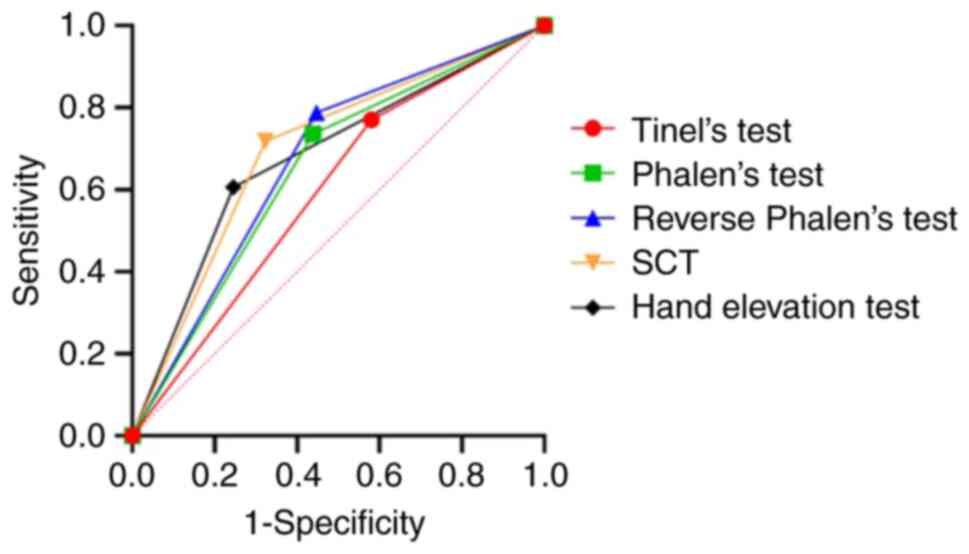|
1
|
Ibrahim I, Khan WS, Goddard N and Smitham
P: Carpal tunnel syndrome: A review of the recent literature. Open
Orthop J. 6:69–76. 2012.PubMed/NCBI View Article : Google Scholar
|
|
2
|
Hanewinckel R, Ikram MA and Van Doorn PA:
Peripheral neuropathies. Handb Clin Neurol. 138:263–282.
2016.PubMed/NCBI View Article : Google Scholar
|
|
3
|
Graham B, Peljovich AE, Afra R, Cho MS,
Gray R, Stephenson J, Gurman A, MacDermid J, Mlady G, Patel AT, et
al: The American Academy of Orthopaedic Surgeons Evidence-Based
Clinical Practice Guideline on: Management of carpal tunnel
syndrome. J Bone Joint Surg Am. 98:1750–1754. 2016.PubMed/NCBI View Article : Google Scholar
|
|
4
|
Mondelli M, Giannini F and Giacchi M:
Carpal tunnel syndrome incidence in a general population.
Neurology. 58:289–294. 2002.PubMed/NCBI View Article : Google Scholar
|
|
5
|
Atroshi I, Gummesson C, Johnsson R,
Ornstein E, Ranstam J and Rosen I: Prevalence of carpal tunnel
syndrome in a general population. JAMA. 282:153–158.
1999.PubMed/NCBI View Article : Google Scholar
|
|
6
|
Hulkkonen S, Shiri R, Auvinen J, Miettunen
J, Karppinen J and Ryhanen J: Risk factors of hospitalization for
carpal tunnel syndrome among the general working population. Scand
J Work Environ Health. 46:43–49. 2020.PubMed/NCBI View Article : Google Scholar
|
|
7
|
Paroski MW and Fine EJ: Sir James Paget
and the carpal tunnel syndrome. Neurology. 35(448)1985.PubMed/NCBI View Article : Google Scholar
|
|
8
|
Jablecki CK, Andary MT, So YT, Wilkins DE
and Williams FH: Literature review of the usefulness of nerve
conduction studies and electromyography for the evaluation of
patients with carpal tunnel syndrome. AAEM Quality Assurance
Committee. Muscle Nerve. 16:1392–1414. 1993.PubMed/NCBI View Article : Google Scholar
|
|
9
|
Campion D: Electrodiagnostic testing in
hand surgery. J Hand Surg Am. 21:947–956. 1996.PubMed/NCBI View Article : Google Scholar
|
|
10
|
Stetson DS, Albers JW, Silverstein BA and
Wolfe RA: Effects of age, sex, and anthropometric factors on nerve
conduction measures. Muscle Nerve. 15:1095–1104. 1992.PubMed/NCBI View Article : Google Scholar
|
|
11
|
LaJoie AS, McCabe SJ, Thomas B and Edgell
SE: Determining the sensitivity and specificity of common
diagnostic tests for carpal tunnel syndrome using latent class
analysis. Plast Reconstr Surg. 116:502–507. 2005.PubMed/NCBI View Article : Google Scholar
|
|
12
|
Ghasemi-Rad M, Nosair E, Vegh A, Mohammadi
A, Akkad A, Lesha E, Mohammadi MH, Sayed D, Davarian A,
Maleki-Miyandoab T and Hasan A: A handy review of carpal tunnel
syndrome: From anatomy to diagnosis and treatment. World J Radiol.
6:284–300. 2014.PubMed/NCBI View Article : Google Scholar
|
|
13
|
Padua L, Coraci D, Erra C, Pazzaglia C,
Paolasso I, Loreti C, Caliandro P and Hobson-Webb LD: Carpal tunnel
syndrome: Clinical features, diagnosis, and management. Lancet
Neurol. 15:1273–1284. 2016.PubMed/NCBI View Article : Google Scholar
|
|
14
|
Graham B, Regehr G, Naglie G and Wright
JG: Development and validation of diagnostic criteria for carpal
tunnel syndrome. J Hand Surg Am. 31:919–924. 2006.PubMed/NCBI
|
|
15
|
Phalen GS and Kendrick JI: Compression
neuropathy of the median nerve in the carpal tunnel. J Am Med
Assoc. 164:524–530. 1957.PubMed/NCBI View Article : Google Scholar
|
|
16
|
Cheng CJ, Mackinnon-Patterson B, Beck JL
and Mackinnon SE: Scratch collapse test for evaluation of carpal
and cubital tunnel syndrome. J Hand Surg Am. 33:1518–1524.
2008.PubMed/NCBI View Article : Google Scholar
|
|
17
|
Ahn DS: Hand elevation: A new test for
carpal tunnel syndrome. Ann Plast Surg. 46:120–124. 2001.PubMed/NCBI View Article : Google Scholar
|
|
18
|
Uncini A, Kujirai T, Gluck B and Pullman
S: Silent period induced by cutaneous stimulation.
Electroencephalogr Clin Neurophysiol. 81:344–352. 1991.PubMed/NCBI View Article : Google Scholar
|
|
19
|
Serrao M, Parisi L, Pierelli F and Rossi
P: Cutaneous afferents mediating the cutaneous silent period in the
upper limbs: Evidences for a role of low-threshold sensory fibres.
Clin Neurophysiol. 112:2007–2014. 2001.PubMed/NCBI View Article : Google Scholar
|
|
20
|
Kofler M: Functional organization of
exteroceptive inhibition following nociceptive electrical fingertip
stimulation in humans. Clin Neurophysiol. 114:973–980.
2003.PubMed/NCBI View Article : Google Scholar
|
|
21
|
Gillenwater J, Cheng J and Mackinnon SE:
Evaluation of the scratch collapse test in peroneal nerve
compression. Plast Reconstr Surg. 128:933–939. 2011.PubMed/NCBI View Article : Google Scholar
|
|
22
|
Huynh MNQ, Karir A and Bennett A: Scratch
collapse test for carpal tunnel syndrome: A systematic review and
meta-analysis. Plast Reconstr Surg Glob Open.
6(e1933)2018.PubMed/NCBI View Article : Google Scholar
|
|
23
|
Blok RD, Becker SJ and Ring DC: Diagnosis
of carpal tunnel syndrome: Interobserver reliability of the blinded
scratch-collapse test. J Hand Microsurg. 6:5–7. 2014.PubMed/NCBI View Article : Google Scholar
|
|
24
|
Makanji HS, Becker SJ, Mudgal CS, Jupiter
JB and Ring D: Evaluation of the scratch collapse test for the
diagnosis of carpal tunnel syndrome. J Hand Surg Eur Vol.
39:181–186. 2014.PubMed/NCBI View Article : Google Scholar
|
|
25
|
Simon J, Lutsky K, Maltenfort M and
Beredjiklian PK: The Accuracy of the scratch collapse test
performed by blinded examiners on patients with suspected carpal
tunnel syndrome assessed by electrodiagnostic studies. J Hand Surg
Am. 42:386.e1–e386.e5. 2017.PubMed/NCBI View Article : Google Scholar
|
|
26
|
Montgomery K, Wolff G and Boyd KU:
Evaluation of the scratch collapse test for carpal and cubital
tunnel syndrome-a prospective, blinded study. J Hand Surg Am.
45:512–517. 2020.PubMed/NCBI View Article : Google Scholar
|
|
27
|
Cebron U and Curtin CM: The scratch
collapse test: A systematic review. J Plast Reconstr Aesthet Surg.
71:1693–1703. 2018.PubMed/NCBI View Article : Google Scholar
|
|
28
|
Ma H and Kim I: The diagnostic assessment
of hand elevation test in carpal tunnel syndrome. J Korean
Neurosurg Soc. 52:472–475. 2012.PubMed/NCBI View Article : Google Scholar
|
|
29
|
Amirfeyz R, Gozzard C and Leslie IJ: Hand
elevation test for assessment of carpal tunnel syndrome. J Hand
Surg Br. 30:361–364. 2005.PubMed/NCBI View Article : Google Scholar
|















